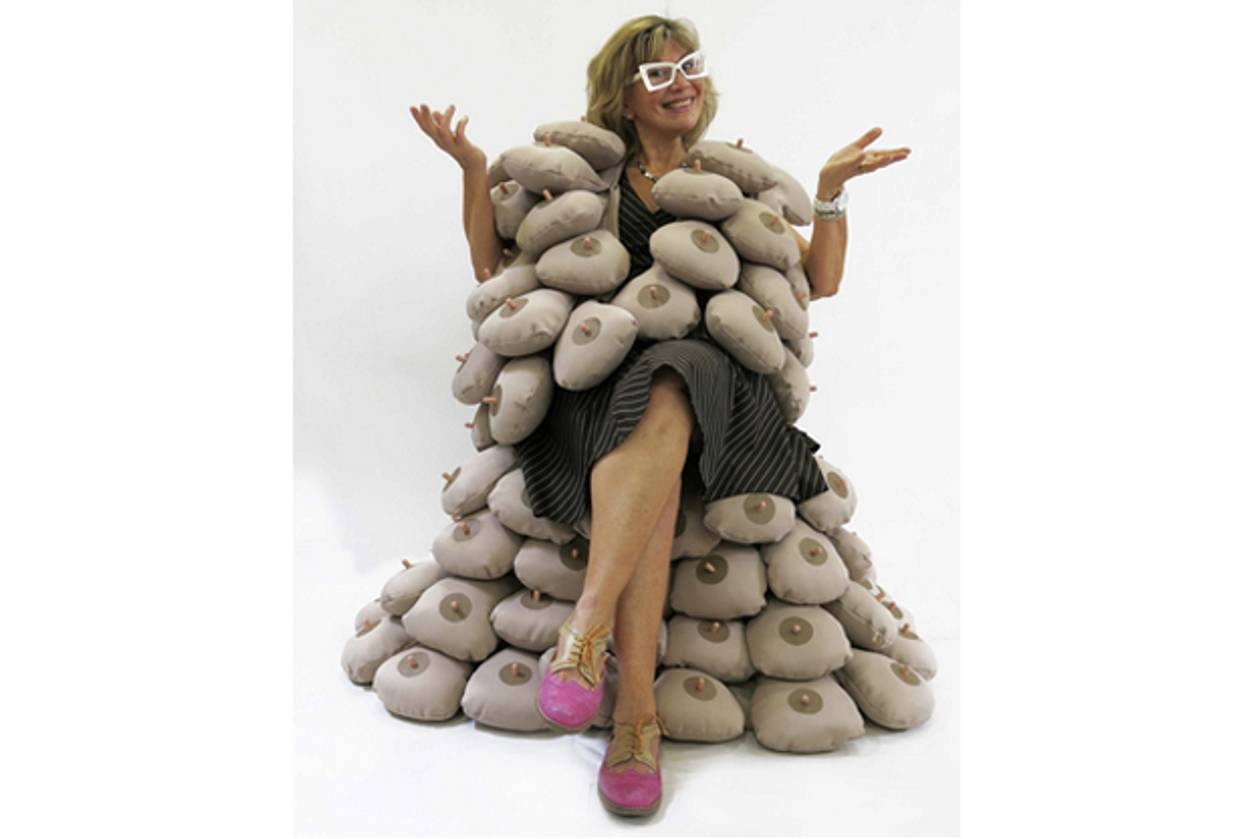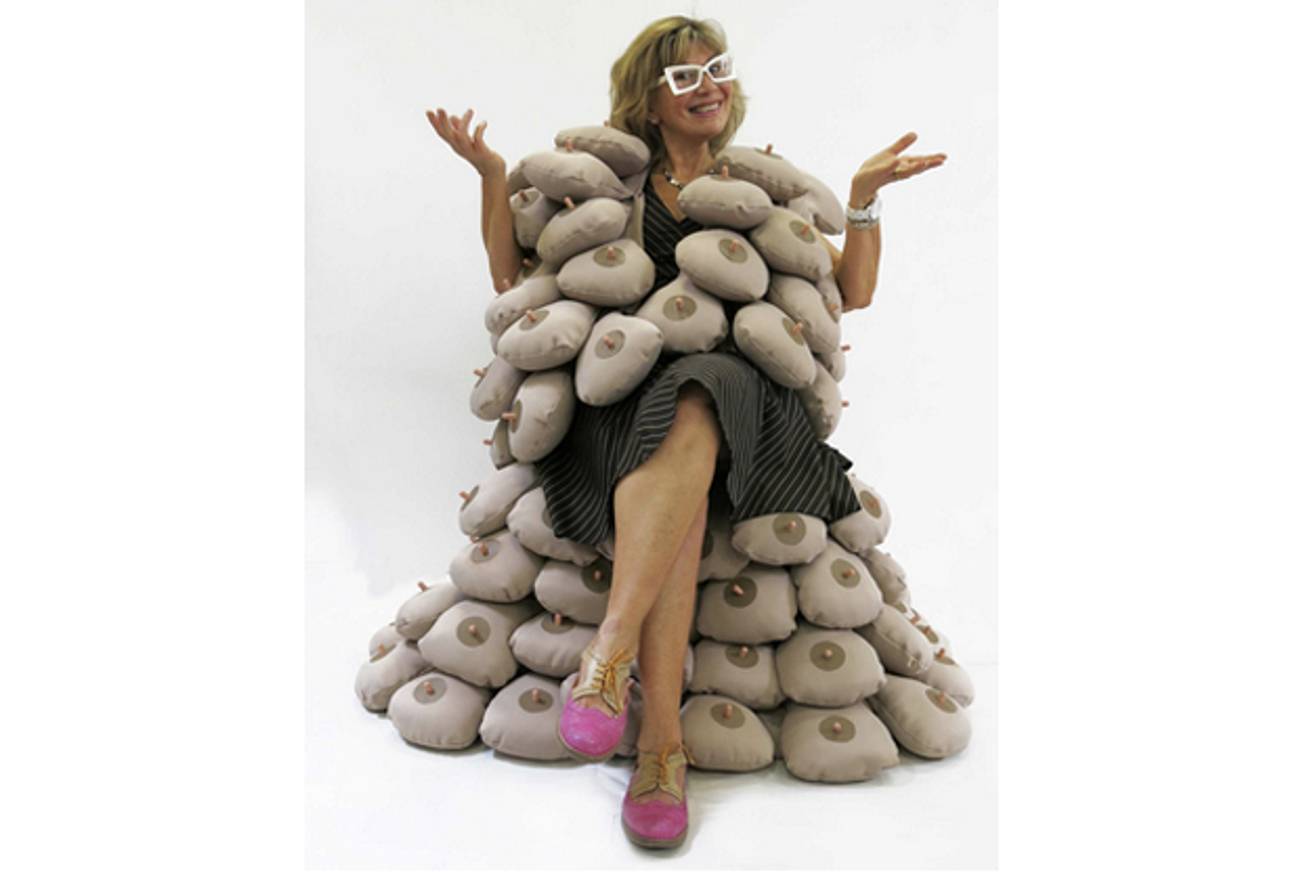Sitting in The Mother of All Chairs
Smothering or mothering? That’s the question artist Mirta Kupferminc asks




A chair made out of breasts. An inhabitable scene from the Garden of Eden. A beautiful woman eating a fig, blood dripping down one leg. These were among the offerings of Argentinian artist Mirta Kupferminc in the culminating ceremony of LABA: A Laboratory for Jewish Culture, in which artists come together to study Jewish texts.
This year’s theme was motherhood, and when the lights came on after a presentation of her 13-minute film Divine Desire, Kupferminc was sitting ensconced in the chair, which is called Eve: Chair of All Mothers and is made out of beanbag breasts, an example of Kupferminc’s wonderful ability to playfully engage with the most serious topics. “At first glance, this work is humorous, even ludicrous,” she explained to the audience. “Sexuality and maternity, this is the way the chain is shaped, l’dor v’dor.”
Kupferminc, elegantly dressed in a black top and slacks, exudes a vibrancy from her sparkling dark eyes, behind red cat-eye glasses, down to her black and red lace up stilettos. Before the show, she reflected on her view of maternity. “It is cozy, it is warm, but it can also smother you,” she explained. The chair and the inhabitable scene from Eden, entitled “S-Naked,” put into practice Kupferminc’s belief that the viewer of an artwork is not an observer—a word she says is too passive—but rather what she calls a “co-liver, the person living in that instant with me through my art.”
In these pieces, the co-liver enters the space Kupferminc has created in order to experience first-hand what it is to be a mother—a “walking boob,” as Kupferminc called it with a big smile, or what it is like to stand behind the story of the Garden of Eden and experience the Divine Desire that led to the Edenic debacle. “You can relax,” Kupferminc told me. “No one is innocent, not Adam, not the snake, and not God. He planned everything. Everyone did what He wanted to be done. If not, why did He put the tree? Why did He put the snake? It is no sin in my opinion. Eve did exactly what she is supposed to do. If she hadn’t sinned, she wouldn’t have had sex, she wouldn’t have had babies, and we wouldn’t be making this interview. I think everything was part of the same order.”
The tension between Kupferminc’s interpretation of the biblical scene mirrored the tension between the written word, as it was studied in the context of LABA, and the sculpture Kupferminc created. “I always say that I don’t like limits, in geography, in ways of expression, and in medias. I work in many medias. I show what I am. The world is very big. I don’t think in advance. I make what I want to make.”
The daughter of Holocaust survivors, Kupferminc grew up haunted by the absence of extended family, photos, documents, and anything that preceded her parents. This lacuna gave Kupferminc a powerful desire to leave a testimony of her own life that would survive her, one which reflects the transgression of boundaries embodied by her biography. “I work very strongly with themes that I show I am Argentinian,” she said, “but in Argentina, I am very identified as an artist that is Jewish.” These themes come up in her other work, including “Borges and the Kabbalah” and “Memory and Identity.”
After the show, the audience was invited to a wine and cheese reception, where “Eve: The Mother of All Chairs” was available to be sat in. A young man in cowboy boots and dark curls was blissfully enveloped in its folds when I arrived. Others were lined up to have their picture taken in the chair, where it would be posted to twitter with the hashtags #LABAlive and #boobchair. When it was my turn, I sat in the chair and pulled its twin panes over my chest. I felt safe and stifled, both warm and aroused. I hightailed out of there.
Batya Ungar-Sargon is a freelance writer who lives in New York. Her Twitter feed is @bungarsargon.